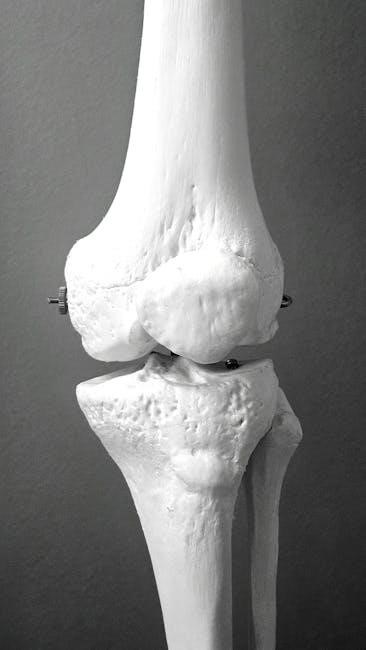The SCID-5 is a semi-structured interview guide for diagnosing DSM-5 disorders, widely used in clinical and research settings. It covers mood, psychotic, substance use, anxiety disorders, and more, aiding accurate diagnoses.
1.1 Overview of the Structured Clinical Interview for DSM-5
The Structured Clinical Interview for DSM-5 (SCID-5) is a semi-structured diagnostic tool designed to assess mental health conditions based on the DSM-5 criteria. It is widely used in both clinical and research settings to ensure accurate and reliable diagnoses. The SCID-5 is organized into diagnostic modules, each focusing on specific categories of disorders, such as mood, anxiety, psychotic, and substance use disorders. Clinicians or trained mental health professionals administer the interview, guiding patients through a systematic evaluation of symptoms and diagnostic criteria. The tool emphasizes flexibility, allowing clinicians to explore additional details while ensuring adherence to DSM-5 standards. Its modular design makes it adaptable to various clinical needs, while its structured format ensures consistency and thoroughness in diagnosis. The SCID-5 is particularly valued for its ability to enhance diagnostic accuracy and inform treatment planning.
1.2 Importance of Structured Interviews in Diagnosis
Structured interviews, such as the SCID-5, are essential for ensuring accurate and reliable mental health diagnoses. They provide a standardized framework for evaluating symptoms and diagnostic criteria, reducing variability in assessments. This consistency enhances inter-rater reliability, meaning different clinicians are more likely to reach the same diagnosis for the same patient. Structured interviews also improve diagnostic accuracy by systematically covering all relevant criteria, reducing the likelihood of missed symptoms. They are particularly valuable in clinical settings for informing treatment plans and in research for ensuring reliable data collection. Additionally, these tools aid in training mental health professionals by teaching them how to apply DSM-5 criteria effectively. Overall, structured interviews like the SCID-5 are critical for achieving precise, reliable, and reproducible diagnostic outcomes in both clinical practice and research environments.

Versions of the SCID-5
The SCID-5 is available in two primary versions: the SCID-5-CV (Clinician Version) for clinical settings and the SCID-5-RV (Research Version) for comprehensive research purposes.
2.1 SCID-5-CV (Clinician Version)
The SCID-5-CV is a semi-structured interview guide designed for clinicians to diagnose DSM-5 disorders in clinical settings. It provides a step-by-step approach to assessing common diagnoses, such as mood, anxiety, and psychotic disorders. The tool includes interview questions aligned with DSM-5 criteria, allowing clinicians to rate symptoms as present or absent. It is intended for use by mental health professionals, including psychiatrists, psychologists, and social workers, who have experience in diagnostic evaluations. The SCID-5-CV is organized into diagnostic modules, making it efficient for routine clinical use. It is available in formats like non-modifiable PDFs, ensuring accessibility for practitioners. This version is particularly valued for its focus on diagnoses most relevant to clinical practice, making it a practical tool for improving diagnostic accuracy and consistency.
2.2 SCID-5-RV (Research Version)
The SCID-5-RV is a comprehensive, semi-structured interview designed for research purposes, ensuring rigorous assessment of DSM-5 disorders. It is primarily used in clinical studies to diagnose a wide range of psychiatric conditions, including mood, psychotic, substance use, and anxiety disorders. Unlike the Clinician Version, the Research Version includes more detailed questions and diagnostic criteria to meet the demands of research protocols. It is typically administered by trained researchers or clinicians and is available in formats such as non-modifiable PDFs. The SCID-5-RV also includes supplementary modules for assessing conditions like personality disorders and prolonged grief disorder. Its structured design ensures consistency and reliability in data collection, making it a cornerstone in psychiatric research and clinical trials.

Training and Education
Training and education are essential for mastering the SCID-5, ensuring accurate and reliable diagnoses. Clinicians and mental health professionals require comprehensive education to administer the SCID-5 effectively.
3.1 Training Requirements for Administering the SCID-5
Administering the SCID-5 requires specific training to ensure accurate and reliable diagnoses. Clinicians or trained mental health professionals must be familiar with DSM-5 criteria and diagnostic processes. Proper training involves comprehensive education on the structure and organization of the SCID-5, including its diagnostic modules and interview techniques. Professionals should have experience in conducting unstructured diagnostic evaluations and understand how to apply the semi-structured format effectively. Workshops, manuals, and supervised practice are essential components of SCID-5 training. Ongoing education and updates are recommended to stay current with DSM-5 changes and refine interviewing skills. This ensures that clinicians can systematically assess psychiatric diagnoses, improving the quality of care and research outcomes.

3.2 Role of the SCID-5 in Mental Health Education
The SCID-5 plays a pivotal role in mental health education by providing a standardized framework for teaching diagnostic skills. It is widely used in training programs for psychiatrists, psychologists, and other mental health professionals to enhance their ability to conduct accurate and reliable diagnostic evaluations. The SCID-5 bridges the gap between theoretical knowledge of DSM-5 criteria and practical application, allowing students to learn how to systematically assess symptoms and arrive at diagnoses. It also serves as a tool for improving interviewing techniques and differential diagnosis skills. By integrating the SCID-5 into education, mental health professionals can develop a deeper understanding of psychiatric disorders and refine their clinical judgment, ultimately improving patient care and research outcomes.
3.3 Resources for Learning the SCID-5
Several resources are available to facilitate learning the SCID-5, including the official SCID-5 User Guide, which provides detailed instructions and examples for administering the interview. Training manuals, workshops, and online courses offer hands-on experience and tips for mastering the tool. The SCID-5-CV and SCID-5-RV versions are accompanied by score sheets and guidelines to ensure proper administration. Additionally, digital platforms and PDF versions of the SCID-5 allow for easy access and reference. These resources are essential for clinicians, researchers, and students to improve their diagnostic accuracy and proficiency in using the SCID-5 effectively. They also support ongoing professional development and staying updated with DSM-5 criteria.
Structure of the SCID-5
The SCID-5 is structured into diagnostic modules, each focusing on specific disorders, with questions aligned to DSM-5 criteria to ensure accurate and organized assessments.
4.1 Diagnostic Modules and Organization
The SCID-5 is organized into distinct diagnostic modules, each corresponding to specific categories of mental disorders, such as mood, psychotic, and anxiety disorders. These modules are designed to systematically assess DSM-5 criteria, ensuring a comprehensive and structured approach to diagnosis. The interview begins with an overview section to gather general information about the patient’s symptoms and history. Subsequent modules are administered based on the patient’s reported symptoms, allowing clinicians to focus on relevant areas. This modular design enhances efficiency and ensures that all diagnostic criteria are thoroughly evaluated. The SCID-5-CV, for example, prioritizes disorders commonly encountered in clinical settings, making it a practical tool for both assessment and treatment planning. This organization ensures clarity and accuracy, aiding clinicians in making reliable diagnoses while maintaining flexibility during the interview process.
4.2 DSM-5 Diagnostic Criteria Integration
The SCID-5 is specifically designed to align with the diagnostic criteria outlined in the DSM-5, ensuring that each question directly corresponds to the criteria for a particular disorder. This integration allows clinicians to systematically evaluate whether a patient’s symptoms meet the thresholds for a diagnosis. The interview questions are structured to address each DSM-5 criterion, enabling clinicians to assess the presence, severity, and impact of symptoms. For example, the SCID-5-CV includes questions that guide the clinician through the diagnostic process, ensuring that all relevant criteria are explored. This alignment enhances the accuracy and reliability of diagnoses, making the SCID-5 a valuable tool for both clinical practice and research. The integration of DSM-5 criteria ensures that the SCID-5 remains consistent with current diagnostic standards.
4.3 Types of Interview Questions
The SCID-5 employs a variety of interview questions designed to gather comprehensive information about a patient’s symptoms and experiences. These include screening questions to identify potential disorders, follow-up questions to clarify symptom presence and severity, and probing questions to gather additional details. The questions are structured to align with DSM-5 criteria, ensuring that each symptom is evaluated systematically. For example, questions may ask about the duration of symptoms, their impact on daily life, and associated distress. The SCID-5 also includes diagnostic questions that directly correspond to specific criteria, allowing clinicians to determine whether a diagnosis is warranted. This structured approach ensures consistency and accuracy in assessment, making the SCID-5 a reliable tool for both clinical and research settings.

Clinical Applications
The SCID-5 is widely used in clinical settings to diagnose DSM-5 disorders, aiding in differential diagnosis, monitoring treatment progress, and guiding therapeutic interventions for mental health conditions.
5.1 Use in Clinical Settings
The SCID-5 is a valuable tool in clinical settings, aiding mental health professionals in systematically diagnosing DSM-5 disorders. It covers mood, psychotic, substance use, and anxiety disorders, among others, ensuring comprehensive assessment. Clinicians use the SCID-5 to guide diagnostic evaluations, improve accuracy, and inform treatment plans. Its structured format helps gather detailed symptom information, enhancing reliability. The interview process allows clinicians to explore patient histories, current symptoms, and functional impairments, facilitating accurate diagnoses. By standardizing the diagnostic process, the SCID-5 supports consistency across clinical practices. It is particularly useful for assessing complex cases and ensuring that diagnoses align with DSM-5 criteria. This tool is essential for clinicians aiming to provide evidence-based care and improve patient outcomes through precise diagnostic evaluations.
5.2 Differential Diagnosis Process
The SCID-5 facilitates the differential diagnosis process by systematically evaluating symptoms across DSM-5 disorders. It helps clinicians distinguish between overlapping conditions by assessing specific diagnostic criteria. The interview structure guides professionals to explore symptoms in depth, ensuring no potential diagnoses are overlooked. By organizing questions according to diagnostic modules, the SCID-5 enables a thorough evaluation of comorbid conditions. Clinicians can systematically rule out alternative diagnoses, enhancing diagnostic accuracy. The tool’s semi-structured format allows for flexibility, enabling clinicians to probe symptoms further when uncertainty arises. This process ensures that diagnoses are based on a comprehensive understanding of the patient’s presentation, improving confidence in the accuracy of the diagnosis. The SCID-5 is particularly valuable in complex cases where multiple disorders may coexist, making it a reliable instrument for differential diagnosis in clinical practice.
5.3 Monitoring Treatment Progress
The SCID-5 serves as a valuable tool for monitoring treatment progress by allowing clinicians to reassess symptoms and diagnostic criteria over time. Its structured format ensures consistency in tracking changes in symptom severity and the presence or absence of specific diagnostic features. Clinicians can use the SCID-5 to evaluate whether a patient’s symptoms have improved, persisted, or evolved during treatment. This process helps in documenting the effectiveness of interventions and identifying areas where adjustments to the treatment plan may be necessary. The SCID-5’s clear and organized approach facilitates communication among healthcare providers, ensuring a unified understanding of the patient’s progress. Regular administration of the SCID-5 can provide longitudinal data, aiding in informed decision-making and personalized care. This makes it an essential resource for ongoing patient management and outcome assessment in clinical settings.
5.4 Cultural Considerations in Administration
Cultural considerations play a critical role in the administration of the SCID-5 to ensure accurate and sensitive diagnoses. Clinicians must account for cultural differences in symptom presentation, interpretation, and communication styles. Misdiagnosis can occur if cultural factors are overlooked, as certain behaviors or expressions of distress may have different meanings in various cultural contexts. The SCID-5 requires clinicians to be culturally aware and sensitive, adapting their approach to the patient’s background while maintaining the integrity of the diagnostic criteria. Language barriers, cultural nuances, and varying expressions of emotional distress must be considered to ensure valid and reliable assessments. Additionally, the use of supplementary tools or cultural formulation guides, as recommended in DSM-5, can enhance the accuracy of diagnoses in diverse populations. This ensures that the SCID-5 remains a fair and effective tool across different cultural settings.

Development of the SCID-5
The SCID-5 was developed following the release of the DSM-5, updating the SCID-IV to align with new diagnostic criteria. It provides a semi-structured format for accurate diagnoses.
6.1 Historical Context and Evolution
The SCID-5 evolved from earlier versions tied to previous DSM editions, with the first SCID developed in the 1990s for DSM-IV. It was designed to standardize diagnostic assessments, ensuring reliability and consistency in clinical and research settings. The transition to DSM-5 in 2013 necessitated significant updates, incorporating new diagnostic criteria and disorders. The SCID-5 was refined to reflect these changes, offering improved modules for assessing conditions like binge-eating disorder and premenstrual dysphoric disorder. The development process involved collaboration among mental health professionals to ensure the tool remained user-friendly while maintaining diagnostic accuracy. Today, the SCID-5 is available in two main versions: the Clinician Version (SCID-5-CV) for everyday practice and the Research Version (SCID-5-RV) for in-depth studies, both adhering to DSM-5 standards.
6.2 Transition from DSM-IV to DSM-5
The transition from DSM-IV to DSM-5 introduced significant changes in diagnostic criteria and disorder classifications. The SCID-5 was updated to align with these revisions, incorporating new disorders, reorganized categories, and modified diagnostic thresholds. For example, the DSM-5 eliminated the Global Assessment of Functioning (GAF) scale and introduced dimensional assessments for certain disorders. The SCID-5 reflected these changes by revising its modules and interview questions to capture the updated criteria. This transition ensured clinicians and researchers could accurately diagnose conditions under the new DSM-5 framework. The SCID-5-CV and SCID-5-RV versions were developed to accommodate these updates, maintaining the tool’s reliability and relevance in both clinical and research settings. This evolution underscores the SCID’s adaptability to advancements in psychiatric diagnosis.
Validation and Reliability
The SCID-5 has undergone rigorous validation studies, demonstrating high inter-rater reliability and consistency in diagnoses. Its structured format ensures reliable scoring across different clinicians and settings.
7.1 Validation Studies and Research
The SCID-5 has undergone extensive validation studies to ensure its accuracy and reliability in diagnosing DSM-5 disorders; Research has consistently shown high inter-rater reliability, with kappa coefficients indicating strong agreement among clinicians. Studies have validated its use across diverse clinical and research settings, demonstrating its effectiveness in assessing mood, anxiety, psychotic, and substance use disorders. The structured format minimizes variability, ensuring consistent diagnoses. Validation studies have also examined its applicability in transcultural contexts, confirming its utility across different populations. These studies highlight the SCID-5’s ability to accurately capture DSM-5 criteria, making it a reliable tool for both clinical practice and research. The evidence supports its role as a gold standard in psychiatric assessment, providing a robust foundation for diagnostic evaluations.
7.2 Inter-Rater Reliability in Diagnosis
The SCID-5 demonstrates strong inter-rater reliability, ensuring consistent diagnoses across clinicians. Studies have shown high agreement, with kappa coefficients indicating robust reliability. The semi-structured format minimizes variability, allowing clinicians to systematically evaluate symptoms. This consistency is crucial in both clinical and research settings, ensuring accurate and reproducible results. The SCID-5’s reliability extends across diverse disorders, including mood, anxiety, and psychotic conditions. Its standardized criteria and probing strategies help clinicians assess symptoms uniformly. This high inter-rater reliability makes the SCID-5 a dependable tool for diagnostic evaluations, reinforcing its role as a gold standard in mental health assessment. The ability to achieve reliable diagnoses across different clinicians underscores its effectiveness in clinical practice and research.

Limitations and Challenges

The SCID-5’s complexity requires skilled clinicians, and its reliance on interviewer expertise can lead to variability. Cultural adaptation challenges and time demands further limit its practical application.
8.1 Complexity of the Interview Process
The SCID-5’s semi-structured design requires substantial clinical expertise, making it challenging for less experienced professionals. The interview process is time-consuming due to its detailed assessment of DSM-5 criteria, which can be overwhelming for both clinicians and patients. Navigating through multiple diagnostic modules demands a high level of organizational skills to ensure accuracy; Additionally, the reliance on clinician judgment increases the potential for variability in interpretations, potentially impacting reliability. The complexity also poses barriers in training, as mastery of the instrument demands extensive practice and familiarity with DSM-5 diagnostic criteria. This intricate process can hinder efficient administration in busy clinical settings, further complicating its practical application.
8.2 Dependence on Clinician Expertise
The SCID-5 requires a high level of clinician expertise to administer effectively, as it relies heavily on the interviewer’s understanding of DSM-5 criteria. Clinicians must interpret complex symptoms, navigate diagnostic nuances, and make informed judgments during the interview. While the semi-structured format provides guidance, the accuracy of diagnoses depends significantly on the clinician’s experience and familiarity with mental health conditions. Inexperienced professionals may struggle to apply the criteria correctly, potentially leading to inconsistent or inaccurate results. This dependence on expertise underscores the need for comprehensive training and ongoing professional development to ensure reliable and valid diagnoses. The SCID-5’s effectiveness is thus closely tied to the skill and knowledge of the clinician administering it.
8.3 Challenges in Cultural Adaptation
The SCID-5 faces challenges in cultural adaptation, as mental health symptoms and diagnostic criteria may vary across cultures. Ensuring cultural sensitivity while maintaining diagnostic accuracy is complex. Differences in how symptoms are expressed, perceived, and reported across cultures can lead to misdiagnosis or underdiagnosis. Additionally, translating the interview into other languages while preserving its validity and reliability poses significant hurdles. Cultural biases in the DSM-5 criteria themselves can further complicate the adaptation process. Clinicians must be trained to recognize and address these cultural nuances to ensure equitable and accurate diagnoses. Despite efforts to incorporate cultural considerations, the SCID-5’s effectiveness across diverse populations remains a challenge that requires ongoing research and refinement.
Future Directions
The SCID-5 will likely undergo updates, integrate with digital platforms, and enhance accessibility, ensuring it remains a vital tool for accurate diagnoses and clinician training.
9.1 Ongoing Research and Updates
Research on the SCID-5 continues to validate its effectiveness and reliability in diagnosing DSM-5 disorders. Studies focus on improving its accuracy and adaptability across diverse populations. Updates aim to refine diagnostic criteria, enhance user-friendliness, and incorporate emerging mental health trends. Digital integration is a priority, with efforts to develop online platforms for easier administration and scoring. Cultural adaptations are also being explored to ensure the SCID-5 remains relevant globally. These updates will help maintain the SCID-5 as a cornerstone in clinical practice and research, ensuring it evolves with advancements in psychiatric care and education.
9.2 Integration with Digital Platforms
The integration of the SCID-5 with digital platforms represents a significant advancement in mental health assessment. Digital tools now enable clinicians to administer the SCID-5 remotely, reducing barriers to diagnosis. Online platforms offer real-time scoring, automated data entry, and improved accuracy. Additionally, digital versions provide training modules for professionals to enhance their interviewing skills. These platforms also facilitate data management and analysis, benefiting both clinical practice and research. The digital format ensures accessibility across diverse settings, from urban clinics to rural areas. Furthermore, digital integration supports cultural adaptations, making the SCID-5 more inclusive for global use. As technology evolves, the SCID-5’s digital integration will continue to streamline diagnostic processes, fostering more efficient and reliable mental health care.

